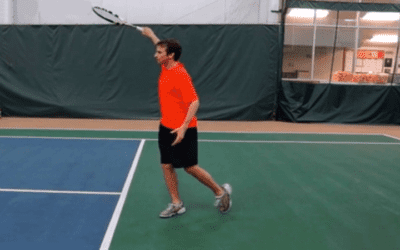Forehand Lesson: How To Handle The Low Forehand

What would it feel like if you could handle the dreaded low forehand? In this tennis forehand lesson, I’ll break down how you can handle the low forehand, whether the ball is in the middle of the court, or out wide. Besides, I’ll share two amazing tennis tips that will provide you complete clarity on what to focus on during practice.
You can improve your low tennis forehand without a partner on the other side of the net. Now, you may be probably lunging and struggling with low balls in the middle of the court. Perhaps, you’re simply miss hitting or missing too many balls in the net.
On the other hand, you’re also getting wide balls that are low, particularly in doubles, but even in singles too. You’re simply reaching out, feeling off balance, and unable to get enough on the ball. Hence, your opponents are taking control of the point and beating you consistently.
Let’s dive into this powerful tennis forehand lesson that will help you to handle these low and wide balls.
Forehand In The Middle Of The Court

To move and swing correctly in the low forehand in the middle of the court, I teach the carioca footwork pattern. When the ball comes low, you want to hit it off your front foot and keep your knees bent.
The low tennis forehand is definitely a time where the knees are going to stay bent; hence, you’ll be pretty low. In fact, you’ve got to get down to the level of the ball without losing your balance. This requires you to develop dynamic balance for handling this ball that comes right at you.
You won’t get this forehand a lot, but you can be aware of it. The carioca footwork pattern is a dynamic movement to help you flow through the ball when it’s low. The higher and lower the ball is, the more that you should move through your strokes.
Wide and Low Tennis Forehand

When the ball is low and wide, I suggest opening up your stance and hitting it off of the outside leg. You want to keep your body low and move through the shot as I explain before. That’s a golden tip right there, move through your shots when you’re under stress.
You’ll take the first step with the outside leg. Then, you’ll swing the front leg as you make contact with the ball. Lastly, you’ll square up to push off and get back in position. Moreover, you’ll need to stay low the whole time and keep your head low as well.
I’ve seen many players reaching and lifting up, which completely throws off their rhythm. You’ll see this ball in doubles, and in singles against the pusher that just uses the slice. That’s a golden tip right there, move through your shots when you’re under stress.
To recap, you can use the carioca footwork pattern to deal with low and wide balls. Besides, you can use the carioca footwork on the slice backhand approach. If you start handling this ball, your whole game is going to open. I hope you enjoyed this tennis forehand lesson and consider practicing these two powerful tips on the court. I’m simply all about deep learning and accelerating your results on the court.
By Jeff Salzenstein, Founder Tennis Evolution
Jeff is a former top 100 ATP player and USTA high performance coach committed to helping players and coaches all over the world improve.
P.S. – Ready to take it to the next level with your tennis? Click here to get a free membership (no credit card required) which includes 21 lessons covering all aspects of your tennis ($567 value). Learn the exact step-by-step system that has transformed the games of thousands. of players worldwide.



0 Comments